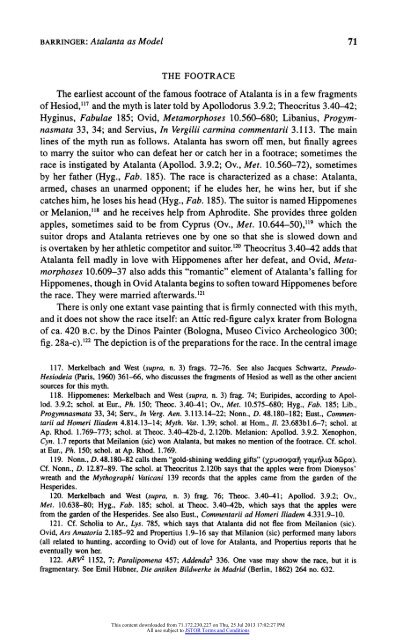Atalanta as Model: The Hunter and the Hunted - Robert Bedrosian's ...
Atalanta as Model: The Hunter and the Hunted - Robert Bedrosian's ...
Atalanta as Model: The Hunter and the Hunted - Robert Bedrosian's ...
Create successful ePaper yourself
Turn your PDF publications into a flip-book with our unique Google optimized e-Paper software.
BARRINGER: <strong>Atalanta</strong> <strong>as</strong> <strong>Model</strong> 71<br />
THE FOOTRACE<br />
<strong>The</strong> earliest account of <strong>the</strong> famous footrace of <strong>Atalanta</strong> is in a few fragments<br />
of Hesiod,"7 <strong>and</strong> <strong>the</strong> myth is later told by Apollodorus 3.9.2; <strong>The</strong>ocritus 3.40-42;<br />
Hyginus, Fabulae 185; Ovid, Metamorphoses 10.560-680; Libanius, Progym<br />
n<strong>as</strong>mata 33, 34; <strong>and</strong> Servius, In Vergilii carmina commentarii 3.113. <strong>The</strong> main<br />
lines of <strong>the</strong> myth run <strong>as</strong> follows. <strong>Atalanta</strong> h<strong>as</strong> sworn off men, but finally agrees<br />
to marry <strong>the</strong> suitor who can defeat her or catch her in a footrace; sometimes <strong>the</strong><br />
race is instigated by <strong>Atalanta</strong> (Apollod. 3.9.2; Ov., Met. 10.560-72), sometimes<br />
by her fa<strong>the</strong>r (Hyg., Fab. 185). <strong>The</strong> race is characterized <strong>as</strong> a ch<strong>as</strong>e: <strong>Atalanta</strong>,<br />
armed, ch<strong>as</strong>es an unarmed opponent; if he eludes her, he wins her, but if she<br />
catches him, he loses his head (Hyg., Fab. 185). <strong>The</strong> suitor is named Hippomenes<br />
or Melanion,18 <strong>and</strong> he receives help from Aphrodite. She provides three golden<br />
apples, sometimes said to be from Cyprus (Ov., Met. 10.644-50),19 which <strong>the</strong><br />
suitor drops <strong>and</strong> <strong>Atalanta</strong> retrieves one by one so that she is slowed down <strong>and</strong><br />
is overtaken by her athletic competitor <strong>and</strong> suitor.'20 <strong>The</strong>ocritus 3.40-42 adds that<br />
<strong>Atalanta</strong> fell madly in love with Hippomenes after her defeat, <strong>and</strong> Ovid, Meta<br />
morphoses 10.609-37 also adds this "romantic" element of <strong>Atalanta</strong>'s falling for<br />
Hippomenes, though in Ovid <strong>Atalanta</strong> begins to soften toward Hippomenes before<br />
<strong>the</strong> race. <strong>The</strong>y were married afterwards.2'<br />
<strong>The</strong>re is only one extant v<strong>as</strong>e painting that is firmly connected with this myth,<br />
<strong>and</strong> it does not show <strong>the</strong> race itself: an Attic red-figure calyx krater from Bologna<br />
of ca. 420 B.C. by <strong>the</strong> Dinos Painter (Bologna, Museo Civico Archeologico 300;<br />
fig. 28a-c).'22 <strong>The</strong> depiction is of <strong>the</strong> preparations for <strong>the</strong> race. In <strong>the</strong> central image<br />
117. Merkelbach <strong>and</strong> West (supra, n. 3) frags. 72-76. See also Jacques Schwartz, Pseudo<br />
Hesiodeia (Paris, 1960) 361-66, who discusses <strong>the</strong> fragments of Hesiod <strong>as</strong> well <strong>as</strong> <strong>the</strong> o<strong>the</strong>r ancient<br />
sources for this myth.<br />
118. Hippomenes: Merkelbach <strong>and</strong> West (supra, n. 3) frag. 74; Euripides, according to Apol<br />
lod. 3.9.2; schol. at Eur., Ph. 150; <strong>The</strong>oc. 3.40-41; Ov., Met. 10.575-680; Hyg., Fab. 185; Lib.,<br />
Progymn<strong>as</strong>mata 33, 34; Serv., In Verg. Aen. 3.113.14-22; Nonn., D. 48.180-182; Eust., Commen<br />
tarii ad Homeri Iliadem 4.814.13-14; Myth. Vat. 1.39; schol. at Hom., I/. 23.683bl.6-7; schol. at<br />
Ap. Rhod. 1.769-773; schol. at <strong>The</strong>oc. 3.40-42b-d, 2.120b. Melanion: Apollod. 3.9.2. Xenophon,<br />
Cyn. 1.7 reports that Meilanion (sic) won <strong>Atalanta</strong>, but makes no mention of <strong>the</strong> footrace. Cf. schol.<br />
at Eur., Ph. 150; schol. at Ap. Rhod. 1.769.<br />
119. Nonn., D. 48.180-82 calls <strong>the</strong>m "gold-shining wedding gifts" (Xpuaoopaxq yac1iXoa Bpa).<br />
Cf. Nonn., D. 12.87-89. <strong>The</strong> schol. at <strong>The</strong>ocritus 2.120b says that <strong>the</strong> apples were from Dionysos'<br />
wreath <strong>and</strong> <strong>the</strong> Mythographi Vaticani 139 records that <strong>the</strong> apples came from <strong>the</strong> garden of <strong>the</strong><br />
Hesperides.<br />
120. Merkelbach <strong>and</strong> West (supra, n. 3) frag. 76; <strong>The</strong>oc. 3.40-41; Apollod. 3.9.2; Ov.,<br />
Met. 10.638-80; Hyg., Fab. 185; schol. at <strong>The</strong>oc. 3.40-42b, which says that <strong>the</strong> apples were<br />
from <strong>the</strong> garden of <strong>the</strong> Hesperides. See also Eust., Commentarii ad Homeri Iliadem 4.331.9-10.<br />
121. Cf. Scholia to Ar., Lys. 785, which says that <strong>Atalanta</strong> did not flee from Meilanion (sic).<br />
Ovid, Ars Amatoria 2.185-92 <strong>and</strong> Propertius 1.9-16 say that Milanion (sic) performed many labors<br />
(all related to hunting, according to Ovid) out of love for <strong>Atalanta</strong>, <strong>and</strong> Propertius reports that he<br />
eventually won her.<br />
122. ARV2 1152, 7; Paralipomena 457; Addenda2 336. One v<strong>as</strong>e may show <strong>the</strong> race, but it is<br />
fragmentary. See Emil Htbner, Die antiken Bildwerke in Madrid (Berlin, 1862) 264 no. 632.<br />
This content downloaded from 71.172.230.227 on Thu, 25 Jul 2013 17:02:27 PM<br />
All use subject to JSTOR Terms <strong>and</strong> Conditions
















